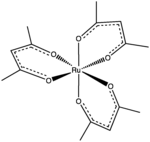Ruthenium(III) acetylacetonate

| |

| |
| Names | |
|---|---|
| IUPAC name
Tris(acetylacetonato)Ruthenium (III)
| |
| Other names
Ru(acac)3; Ruthenium (III) 2,4-Pentanedionate; Ruthenium (III) acetylacetonato, 2,4-pentanedione ruthenium (III)
| |
| Identifiers | |
3D model (JSmol)
|
|
| EC Number |
|
PubChem CID
|
|
| |
| |
| Properties | |
| (C5H7O2)3Ru | |
| Molar mass | 398.39 g/mol |
| Appearance | Dark violet solid |
| Density | 1.54 g/cm3[1] |
| Melting point | 260 °C (500 °F; 533 K) |
| insoluble in water | |
| Solubility | soluble in most organic solvents |
| Hazards[2] | |
| GHS labelling: | |

| |
| Warning | |
| H302, H315, H319, H335, H413 | |
Except where otherwise noted, data are given for materials in their standard state (at 25 °C [77 °F], 100 kPa).
| |
Ruthenium(III) acetylacetonate is a coordination complex with the formula Ru(O2C5H7)3. O2C5H7− is the ligand called acetylacetonate. This compound exists as a dark violet solid that is soluble in most organic solvents.[3] It is used as a precursor to other compounds of ruthenium.
Preparation
In 1914 tris(acetylacetonato)ruthenium (III) was first prepared by the reaction of ruthenium(III) chloride and acetylacetone in the presence of potassium bicarbonate.[4] Since then, alternative synthetic routes have been examined, but the original procedure remains useful with minor variations:[5]
- RuCl3•3H2O + MeCOCH2COMe → Ru(acac)3 + 3 HCl + 3 H2O
Structure and properties
This compound has idealized D3 symmetry. Six oxygen atoms surround the central ruthenium atom in an octahedral arrangement. The average Ru-O bond length in Ru(acac)3 is 2.00 Å.[1] Because Ru(acac)3 is low spin, there is one unpaired d electron, causing this compound to be paramagnetic. Ru(acac)3 has a magnetic susceptibility, χM, of 3.032×10−6 cm3/mol with an effective magnetic moment, μeff, of 1.66 μB.[6] As a solution in dimethylformamide, the compound oxidizes at 0.593 and reduces at -1.223 V vs the ferrocene/ferrocenium couple.[7]
Reduction of Ru(acac)3 in the presence of alkenes affords the related diolefin complexes. Typically, such reactions are conducted with zinc amalgam in moist tetrahydrofuran:[8]
- 2 Ru(acac)3 + 4 alkene + Zn → 2 Ru(acac)2(alkene)2 + Zn(acac)2
The resulting compounds are rare examples of metal-alkene complexes that reversibly sustain oxidation:
- Ru(acac)2(alkene)2 ⇌ [Ru(acac)2(alkene)2]+ + e−
The complex has been resolved into individual enantiomers by separation of its adduct with dibenzoyltartaric acid.[9]
References
- ^ a b Chao, G.; Sime, R. L.; Sime, R. J. (1973). "Crystal and molecular structure of tris(acetylacetonato)ruthenium(III)". Acta Crystallographica B. 29 (12): 2845. doi:10.1107/S0567740873007636.
- ^ "C&L Inventory". echa.europa.eu.
- ^ R. C. Mehrotra, R. Bohra, and D.P. Gaur "Metal β-Diketonates and Allied Derivatives", 1st ed.; Academic Press inc.: New York, 1978. ISBN 0-12-488150-5.
- ^ Barbieri, G. A. (1914). "Systematic chemical investigations: ruthenium, rhodium, palladium". Atti Accad, Lincei. 23 (1): 334–40.
- ^ Gupta, A. (2000). "Improved synthesis and reactivity of tris(acetylacetonato)ruthenium(III)". Indian Journal of Chemistry, Section A. 39A (4): 457. ISSN 0376-4710.
- ^ Grobelny, R. (1966). "The absorption spectra and magnetic properties of the chelated compounds of Ru(III) with β-diketones". Journal of Inorganic and Nuclear Chemistry. 28 (11): 2715–2718. doi:10.1016/0022-1902(66)80398-6.
- ^ Paul Sharpe; N. George Alameddin; David E. Richardson (1994). "Alkyl Substituent Effects in the Redox Thermochemistry of Coordination Compounds: Oxidation and Reduction Energetics for Ruthenium Tris(β-diketonate) Complexes in Solution and the Gas Phase". Journal of the American Chemical Society. 116 (24): 11098–11108. doi:10.1021/ja00103a027.
- ^ Bennett, M. A.; Byrnes, Matthew J.; Kováčik, Ivan (2004). "The fragment bis(acetylacetonato)ruthenium: a meeting-point of coordination and organometallic chemistry". Journal of Organometallic Chemistry. 689 (24): 4463. doi:10.1016/j.jorganchem.2004.07.027.
- ^ Drake, A. F.; Gould, J. M.; Mason, S. F.; Rosini, C.; Woodley, F. J. (1983). "The optical resolution of tris(pentane-2,4-dionato)metal(III) complexes". Polyhedron. 2 (6): 537–538. doi:10.1016/S0277-5387(00)87108-9.
{{cite journal}}: CS1 maint: uses authors parameter (link)
- CS1 maint: uses authors parameter
- Articles without InChI source
- Chemical pages without ChemSpiderID
- Articles without EBI source
- Articles without KEGG source
- Articles without UNII source
- Pages using collapsible list with both background and text-align in titlestyle
- Chembox having GHS data
- Articles containing unverified chemical infoboxes
- Chembox image size set
- Articles with short description
- Short description with empty Wikidata description
- Ruthenium complexes
- Acetylacetonate complexes
- Ruthenium(III) compounds